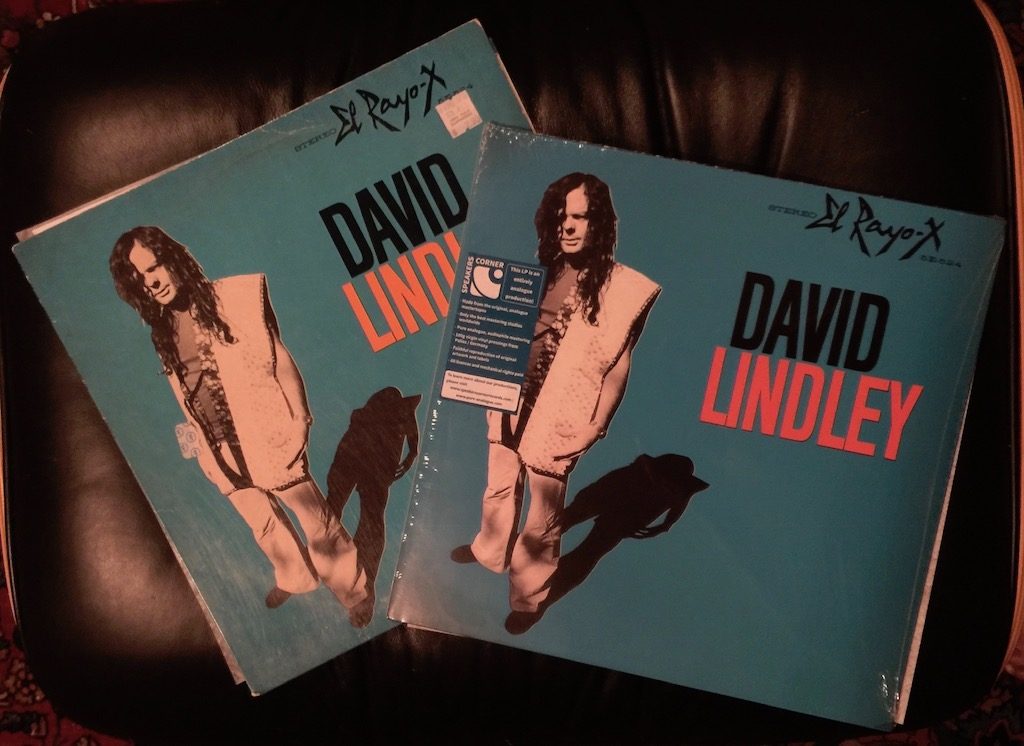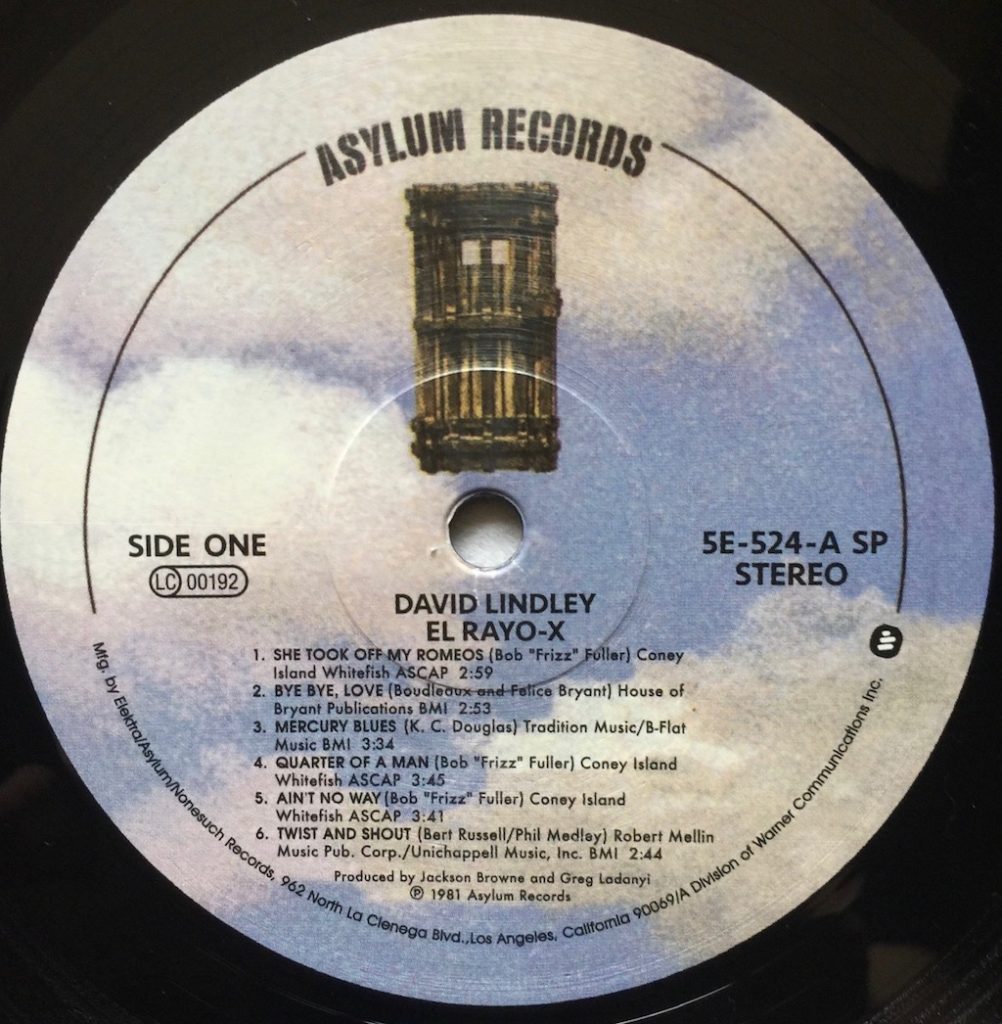David Lindley- El Rayo-X Speakers Corner Re-Master

David Lindley is a national treasure. He’s been doing this a long time, and has appeared on a lot of famous records, including a number of the big hit albums starting in the ‘70s, many from musicians based or recorded in Los Angeles: Linda Ronstadt, Jackson Browne, James Taylor, Terry Reid, Graham Nash, Little Feat and hundreds of other records (and as many live appearances) as a sideman wielding a variety of stringed instruments. He’s had bands (Kaleidiscope; El Rayo-X) and still tours, often as a one-man show.
I’ve heard him many times, both as a sideman for some of the brand name talent mentioned above[1]and as a solo performer. My wife, Liz, remarked after hearing him for the first time during one such solo performance at a local club, “he’s like Yo-Yo Ma—a virtuoso.” She’s not one for hyperbole. David Lindley is that good.
With the resurgence of so-called “Americana” music, Lindley’s music becomes even more relevant. He can draw you in with a simple home-spun tune that sounds like it was written before the dawn of recorded music, then overlay that with sliding lead parts and counterpoint that makes you wonder where he’s hiding the other musicians on stage.
Lindley also has that “old LA sick sense of humor”; acerbic, tuned into the strangeness of life, and probably has a million war stories. Lindley’s a genre chameleon of sorts- it’s hard to pin down exactly what he’s centering on, because he can do so much—take a folk ballad into reggae territory, or a blues song into a psychedelic frenzy or rock a Tejano-style tune into blistering distortion on the slide.
Lindley’s first solo album, El Rayo-X, showcases all of this musicianship, along with some of the zaniness that makes hearing the man live such a treat. You get the sense after playing on so many big hit records with so many famous artists, all Lindley wanted to do was create something that drew on his talents and amuse himself (and others). No aiming for the charts on this one: It’s all great fun mixed with killer playing. And there are a few guests snuck in – Jackson Browne sings, and Bill Payne, one of my all time favorite keyboard players, does his thing. Garth Hudson even makes an appearance!
Produced by Jackson Browne and originally released on Asylum, the album has been given the audiophile treatment by Speakers Corner in a new release cut by Kevin Gray and pressed at Pallas.
The original album wasn’t too shabby on the production side and was mastered by Doug Sax.
Is there room for improvement on what is probably not a staple in most audiophiles’ collections anyway?
I had an early, clean playing copy to hand (mastered by Sax and pressed at Allied Records). According to the sticker, I paid a few bucks for it.

Speakers Corner was kind enough to send me their re-master. This is a company that is very upfront about sources- the label on the shrink says:

Their packaging also replicates the original record, including the lyric insert. The record itself is of the heavier variety. My copy was flawless.
Musically, the album is very eclectic. The songs aren’t about Lindley’s voice, but the musicianship, the quirky lyrics and a sort of “gonzo” approach to the whole endeavor.

Side one starts with “She Took Off My Romeos,” which sounds like an older style pop song cast into an island beat. You can hear more kick drum and bass thrust on the re-master, though on this track the differences are not as pronounced as they are on other tracks.
“Bye Bye Love” is usually pure nostalgia. Here, the accordion gives it a different dimension. The kick drum is weightier on the Speakers Corner.
“Mercury Blues” is a signature tune for Lindley- it gives him the opportunity to crank that slide sound to distorted levels and rock out. The percussion on both copies cuts through the din, but the skin on the struck drums is more evident and when Lindley rips, the tone of his guitar is a little thicker on the Speakers Corner.
“Quarter of a Man,” composed by the same friend of Lindley’s who wrote “Romeos,” is reggae back beat- a story about a “quarter of a man… [w]ith a quarter of a car… [b]ut he only saves a quarter…”. The sonics are stunning on this tune and probably the showstopper on this side. It’s less busy sounding, and that slow reggae beat just pulls you in; when the toms are struck, they have more weight and tone on the Speakers Corner. The bass has a little more gravitas too.
“Ain’t No Way” is (even) more absurd, a story about sitting in the Laundromat “trying to keep clean 25 women arrive on the scene…”. It starts with a held organ note as the Leslie spins faster and slower. There’s a plucked string sound, almost like banjo (which is not credited) that gives the tune a countrified twang but just for a moment— and then it goes into a Caribbean lilt.
You could imagine Jackson Browne doing this song “straight” and making it a hit, but Lindley doesn’t want to settle for the hooks, although they’re here. More weight to the sound on the Speakers Corner on this one too.
Side one finishes with “Twist and Shout” a rock and roll standard played Caribbean style with a Cajun flavor; there’s a plastic-y organ sound that vibes ’60s, but also an exotic flavor that converts it from straight old school rock ‘n roll to something altogether different. The drum thwacks have more punch on the Speakers Corner; their pitch sounds a little higher on the Asylum pressing, which sounds brighter overall on this song.

Side two begins with the title song, a south of the border tune with Cajun spice—you could play this at a dance party and people would go wild. The original pressing sounds a little bright here- the Speakers Corner gives you more—tonally, dimensionally and lends a little more gravitas to the voices and instruments that make it less a radio ditty and more of band playing on the patio. There’s a hell of a lot going on here—and it sounds less cluttered on the Speakers Corner. The title track is pretty instructive of the differences in the sound of the pressings; here, the Speakers Corner just shines.
“Your Old Lady”—starts as rock blues but morphs into an ‘ahh, ahh, ahh’ sound of Brit-pop and then goes into the lyrics- “your old lady sure looks good to me…”. Lindley gets to slide and shimmer here and we’re back to the verse. The guitar work is a perfect demonstration of why Lindley is regarded as a musician’s musician.
The sound is centered a little higher in the range- more mid bass- on the Asylum. The guitar work on the Asylum copy has good leading edges but doesn’t have quite the body of the Speakers Corner. The track simply has more gravitas on the re-master; the rhythm parts are chunkier, more bass drum, and when Lindley’s guitar comes in, it is more “all there.”
“Don’t Look Back”-Jackson Browne actually does sing on this track- is characteristic Lindley—a hot pot of rhythms, with some beautiful string parts and that island beat—a drum strike interrupts and the guitar takes a bittersweet swing and we’re back to the chorus. The Asylum has more edge, which can be nice on some of the percussion, but overall, there’s more everything to the Speakers Corner- weight, shape of instruments, punch. (Though I like the kick drum sound on the early copy very much). The guitar is brighter on the Asylum.
“Petit Fleur”-you could easily hear The Band doing this song—it’s tuneful, and here, Lindley brings us home on the fiddle—another beauty. This track sounds really good on the Asylum copy. The dulcimer strikes are very clear and you can hear the body and string/bow sound of the fiddle like it’s there. The Speakers Corner has better bass, and the overall tonality of the thing is warmer- it doesn’t emphasize the dulcimer but it’s there, chime-y after tones more than the hammer strikes. So too with the fiddle- more body. It’s like the Asylum copy can grab your attention at first but the entire presentation is more complete on the Speakers Corner.
“Tu-Ber-Cu- Lucas and The Sinus Blues” reminds of the “Summertime Blues” but it’s completely different sounding in every respect because its got a different beat and a Latin influence. Tonally, the Asylum sounds like it’s playing at a higher register.
The album finishes with “Pay the Man”—everybody “gotta pay the man…”. Here the organ has body and you could envision this as a send up of a rock ballad/lament with a gospel aspect—it’s a little political and there’s a nice sense of balance between the instruments; the symmetry of the chorus/verse is very satisfying.
The original Asylum pressing really did it for me on this track- more bite to the instruments, but it works. Then you hear the Speakers Corner– which has more punch and deeper tonality on the bass and kick drum. The vocal becomes even weirder on the Speakers Corner (in a good way) because the high pitch of the voice contrasts more with the sound of the instruments. The Speakers Corner has more meat on the bones.
I can imagine Lindley reading all this and saying ‘what nonsense’- I didn’t intend any of that. (Sort of the Marshall McLuhan moment in Annie Hall if you know what I mean…). I did reach out to Mr. Lindley to see if he’d add a few words here, but figured you want to read this before I never hear from him.

How to explain these differences? My impression of Kevin Gray’s approach is that he tries to respect the sound that the original producer sought to achieve. I asked whether the differences I heard here were largely a result of improvements in the mastering chain. Kevin Gray was kind enough to respond:
On this record, I did no compression/limiting in the mastering. When I’ve compared the master tape to the records Doug mastered, his system usually seemed lacking in the bottom octave. I’m sure Doug sometimes compensated for that with EQ, but it was a result of the system he used.
As to the album itself, it’s an interesting, quirky choice and Speakers Corner deserves a nod for doing something that is not on the normal roster of audiophile reissues. You can find one in a bin for cheap, or get one with better sound, which enhances the musical experience. Given how good Lindley and company are, I know what my choice would be….
Bill Hart
Austin, TX
February 2019
[1]There was a coterie of musicians that supported these acts that I refer to as the “California Rock Mafia” and included such notable players as Leland Sklar, Russ Kunkel, Danny Kortchmar, Craig W. Doerge, Peter Asher, Jim Keltner and guest appearances by other well known players, ranging from Graham Nash and Lowell George to Victor Feldman, and Waddy Wachtel. Let’s not forget Warren Zevon and the amazingly gifted Andrew Gold, who contributed so much to Linda Ronstadt’s sound.
*Photo of Lindley, et. al. Marjorie Rossiter (courtesy of Rob Stoner)
Bill, with this review you have exceeded your already extremely high standards! It is in this album that our musical tastes overlap; David Lindley is one of both our favorite living musicians. And how rare is it to have an album that is both so musically delightful and sonically excellent? A lot of my favorite music was unfortunately rather indifferently recorded, even in Pop music terms. Not this album! I have long used it (in its’ original Asylum LP form, of course) for evaluating hi-fi equipment, and will now have to get this newly-remastered and pressed edition. Thanks again Bill for all your great coverage of overlooked music and the multiple LP’s it is available on—Eric.